Nial Moores, Birds Korea, November 2024
Following very strong northwesterly winds in late October 2024 no fewer than 5-10 presumed hybrid Silver-throated Bushtit Aegithalos glaucogularis 검은턱오목눈이 x Long-tailed Tit Aegithalos caudatus 오목눈이were observed on Baengnyeong Island, Incheon (Republic of Korea). These hybrids were in among 50-60 caudatus and magnus Long-tailed Tits seen on two different dates contained in rapidly-moving flocks. Both species sound similar; many of the individuals were not seen well; some of those which were seen well were very “obvious” hybrids with nominate caudatus; and a few were more likely hybrids with magnus Long-tailed Tit (or perhaps were second or third generation?), and might well have been misidentified as “pure” Silver-throated if there were no good images.

Thanks to several contributing birders, most especially Kai Pflug in Shanghai, Terry Townshend in Beijing and Kim Eojin here in Korea, the following post aims to help with the identification and documentation of Silver-throated Bushtits, hybrid Silver-throated Bushtits x caudatus and magnus Long-tailed Tits, and intergrade magnus and caudatus Long-tailed Tits.
In spite of an overlap in vocalisations and massive variation in the plumage of Long-tailed Tit across its Eurasian range, the Silver-throated Bushtit was split from the slightly larger Long-tailed Tit following publications in 2008 and 2010 (per Gill et al. 2024), and is found regularly only in PR China. The species is currently a genuine rarity in the Republic of Korea (ROK).

There are two subspecies of Silver-throats: vinaceus of central and North-east China, and the more southerly-distributed nominate glaucogularis of “East central China” (Gill et al 2024), presumably more or less confined to Jiangsu, Hubei, Anhui and Zhejiang Provinces.
Adults of both subspecies are grey above (lacking any pink), with very broad black lateral crown stripes and black foreheads and a dark throat patch tipped paler, giving the species their scientific and English (“silver-throated”) and Korean (“black-throated”) names. According to Geldard et al. (2020), the more northern-distributed vinaceus, differs from the nominate subspecies “in having side of head and throat slightly paler, underparts also slightly paler, breast less intensely washed buff, but often marked by gorget of marginally darker and browner streaks, tail longer.” According to online images, e.g. here, the dark-headed juveniles of both subspecies are also extensively grey on the upperparts and they also show much more intense reddish-pink on the breast than any juvenile Long-tailed Tit in East Asia.
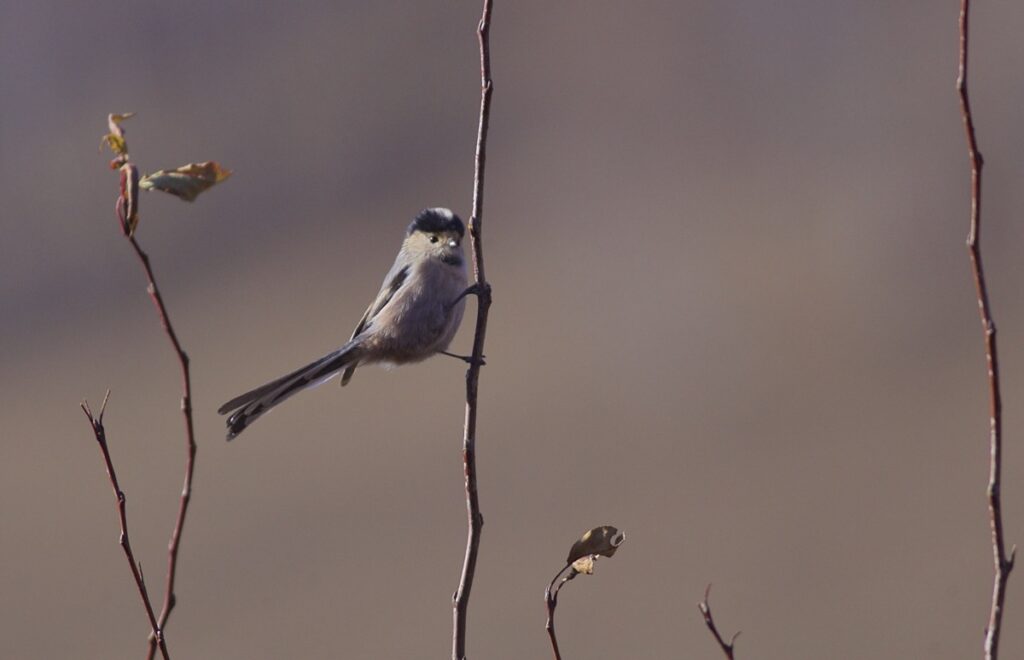
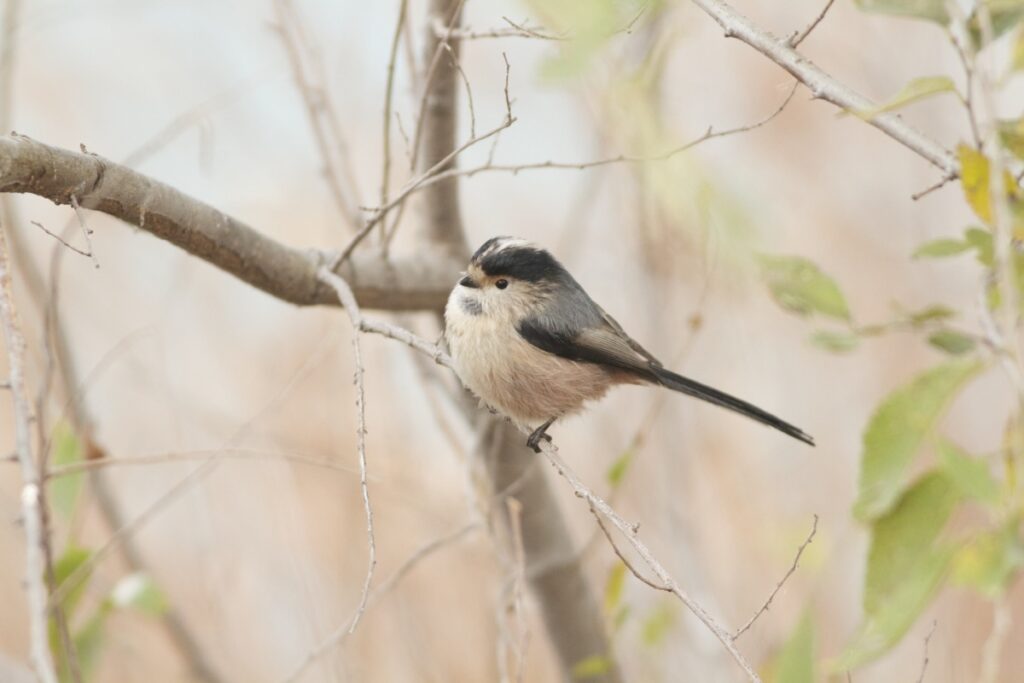

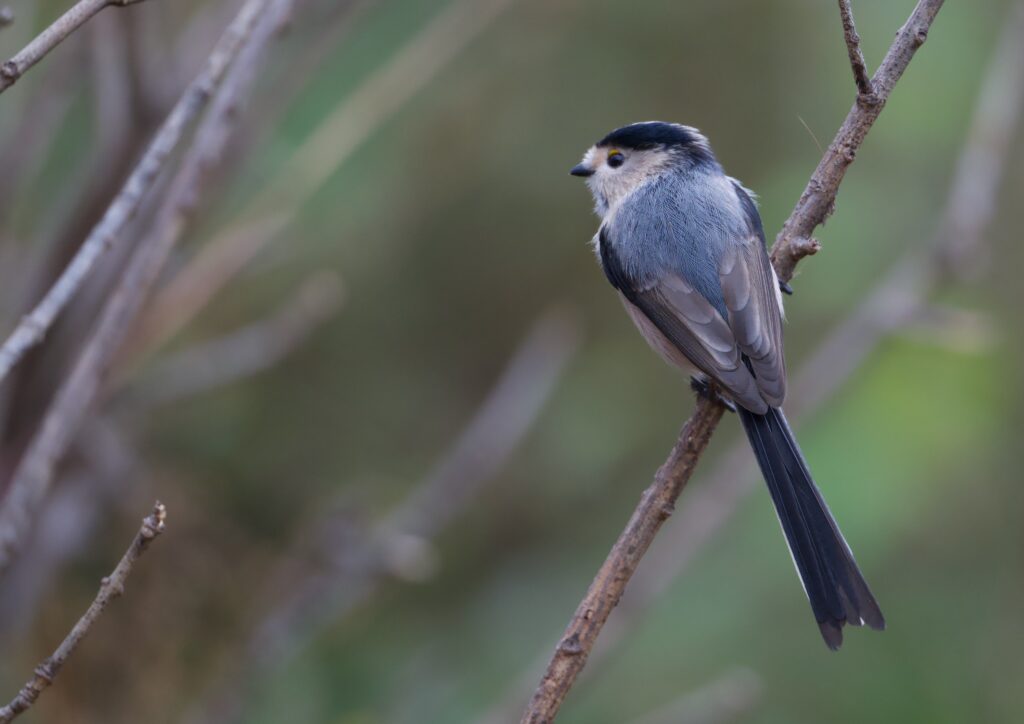
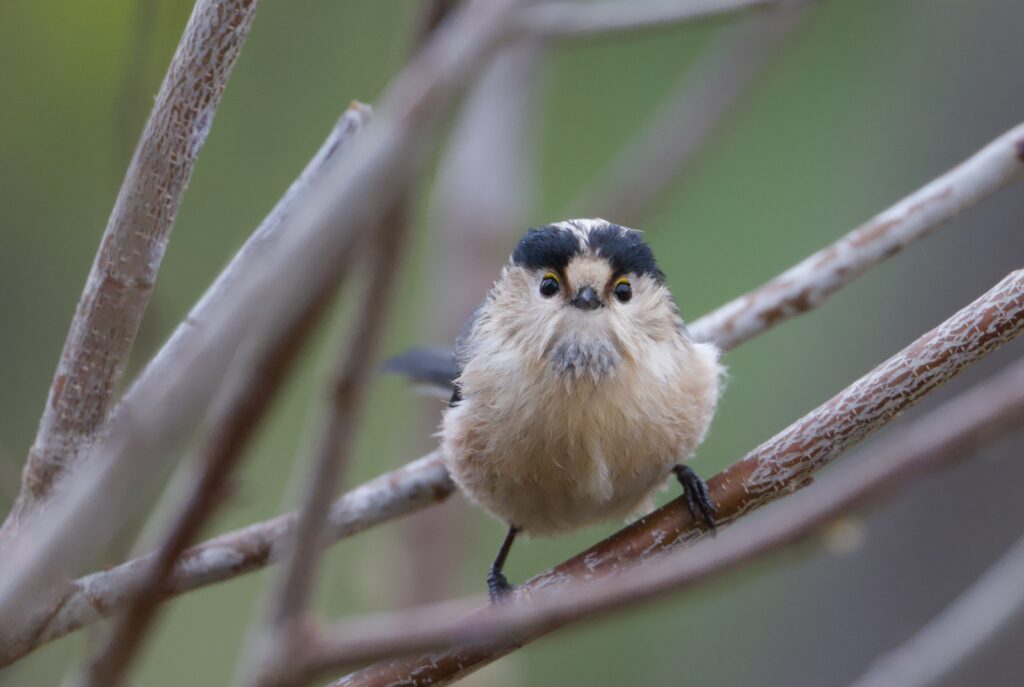
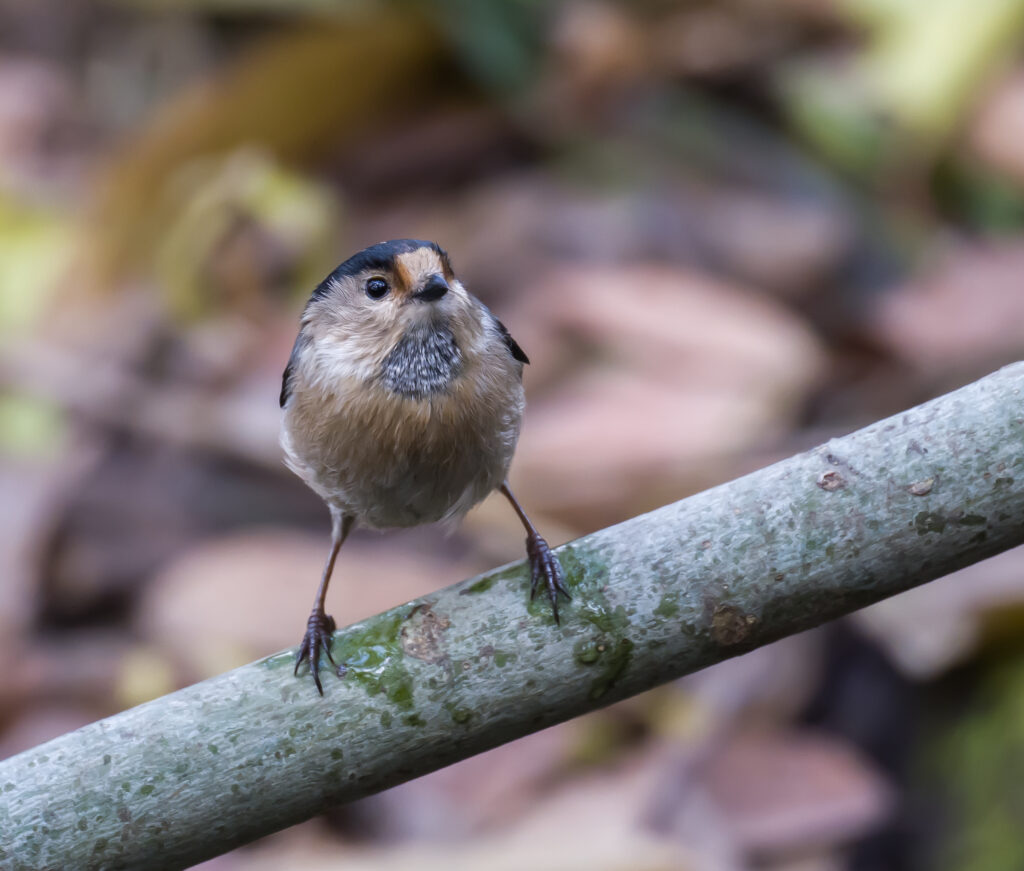
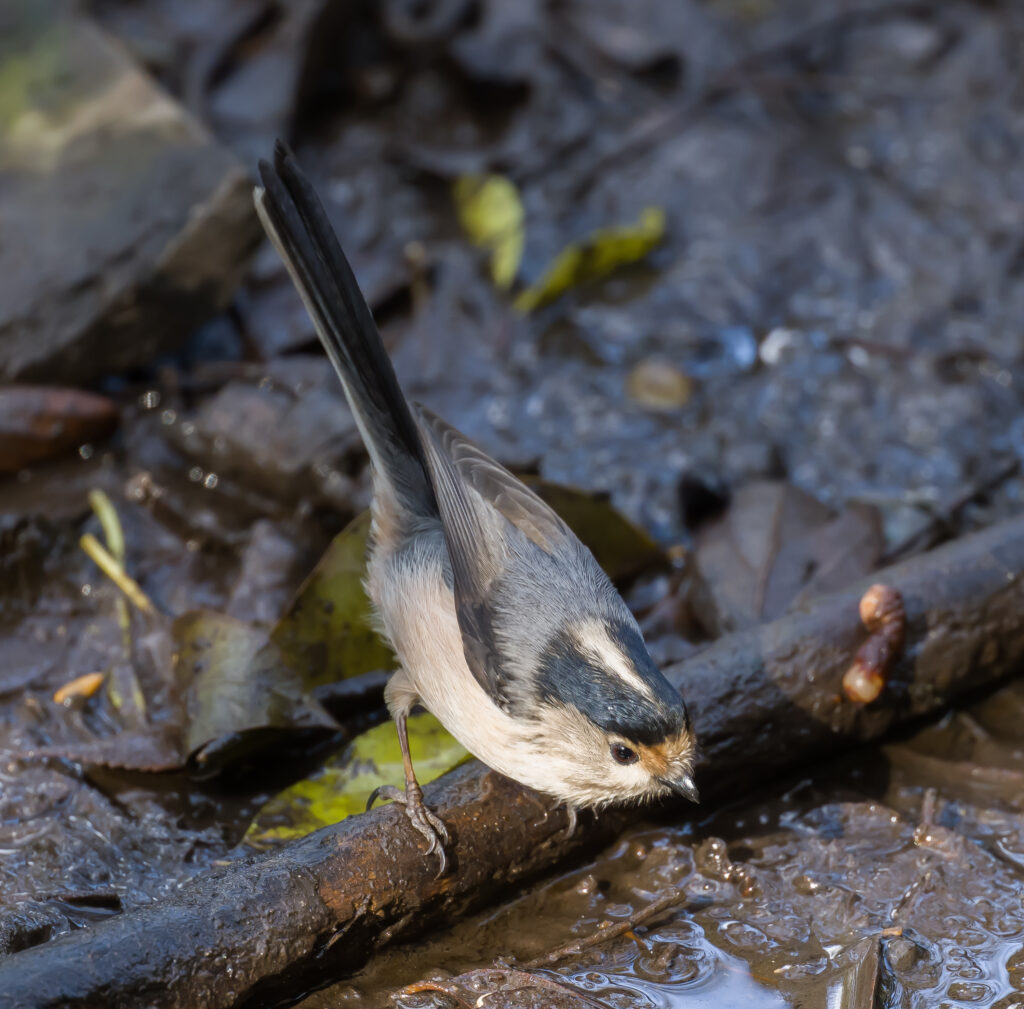
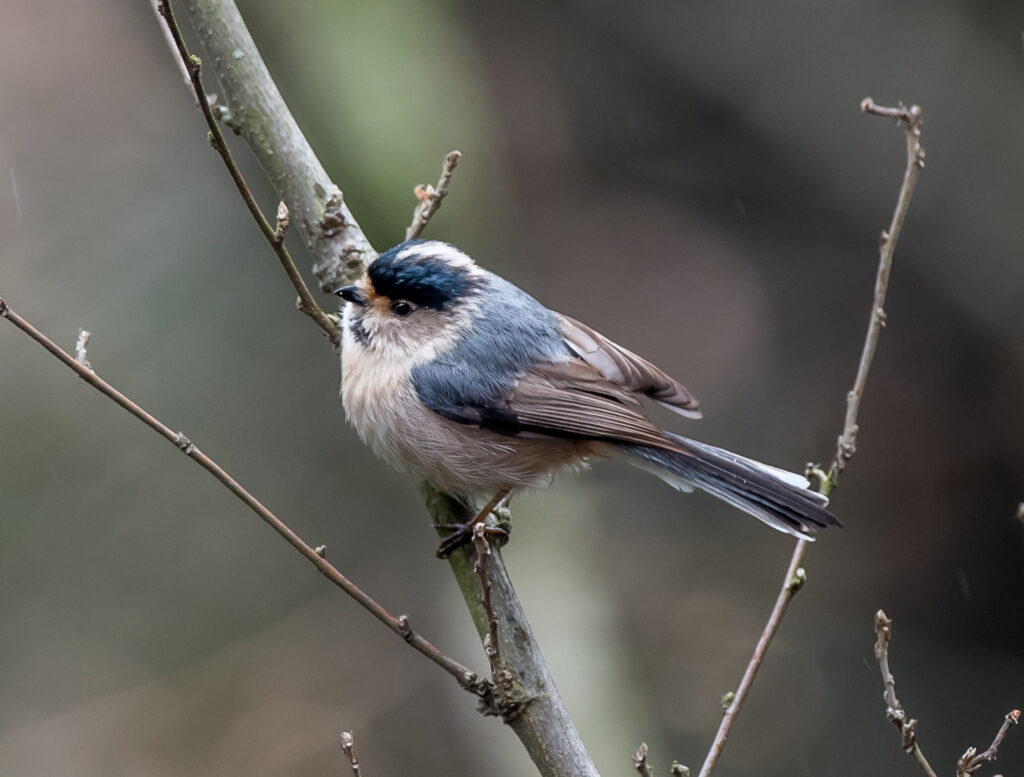

The first Korean record of Silver-throated Bushtit was of two on Socheong Island in March 2022 found by the Migratory Bird Research Centre staff. The second and third records were of two and four individuals respectively which I found on nearby Baengnyeong Island in May and November the same year (though see below).
Both times, the Silver-throated Bushtits on Baengnyeong Island were in a large mixed flock of magnus and caudatus Long-tailed Tits, with several juveniles present in May (both subspecies breed on the island).
The plumages of the May Baengnyeong Silver-throated Bushtits were very worn and while sharing all the widely-expected features of the species, one or both showed a near break in the black on the forehead. Based on images in the online Macaulay library, and as suggested above and by Terry Townshend (in lit. Nov. 2024), a narrow break in the black forehead band seems to be a feature shown (fairly) often by birds in and around Beijing. In combination with their long-tailed look, it therefore seems reasonable to identify the birds on Baengnyeong as belonging to subspecies vinaceus, as currently listed in the 2022 Birds Korea Checklist.


In 30 minutes or so of observations on May 30th 2022 , the Silver-throateds were often followed by juvenile Long-tailed Tits which were begging food. The Silver-throated Bushtits were not seen to feed these juveniles, but they did seem to respond to them, sometimes while carrying food and could have been feeding them when out of view. Cooperative feeding, in which adults feed young from other broods, is known in Long-tailed Tit (Harrap 2020), confusing any inferences on breeding. Were the Silver-throated Bushtits on Baengnyeong involved in feeding the young offspring from pairs of Long-tailed Tits, or might one or both of them have been the actual parents?
Figure 15 shows that one of the begging juveniles has a fairly strong pink wash across the breast – while at least some other juveniles did not. Juvenile Long-tailed Tit and Silver-throated Bushtits both start feathered life largely dark-headed, with the adult head pattern emerging over time. However, juvenile Silver-throated Bushtits show extensive grey on the upperparts (like at least some hybrids: see Figures 1, 2 and 28), while juvenile Long-tailed Tits, like adults are dark-naped and backed, but with contrastingly paler scapulars. In addition, Silver-throateds, look highly contrasting below, with intense red-toned saturation on the breast, while juvenile Long-tailed Tits in East Asia are white-breasted (though a few images of juvenile Long-tailed Tits in the Macaulay library from Korea and Japan do show a fairly or very restricted pink wash). The pink flush across the whole breast shown by the bird in Figure 15, combined with the dark forehead bar, makes it tempting to consider that this juvenile might be from a hybrid pairing. Unfortunately, I failed to take any images of the upperparts of this juvenile.


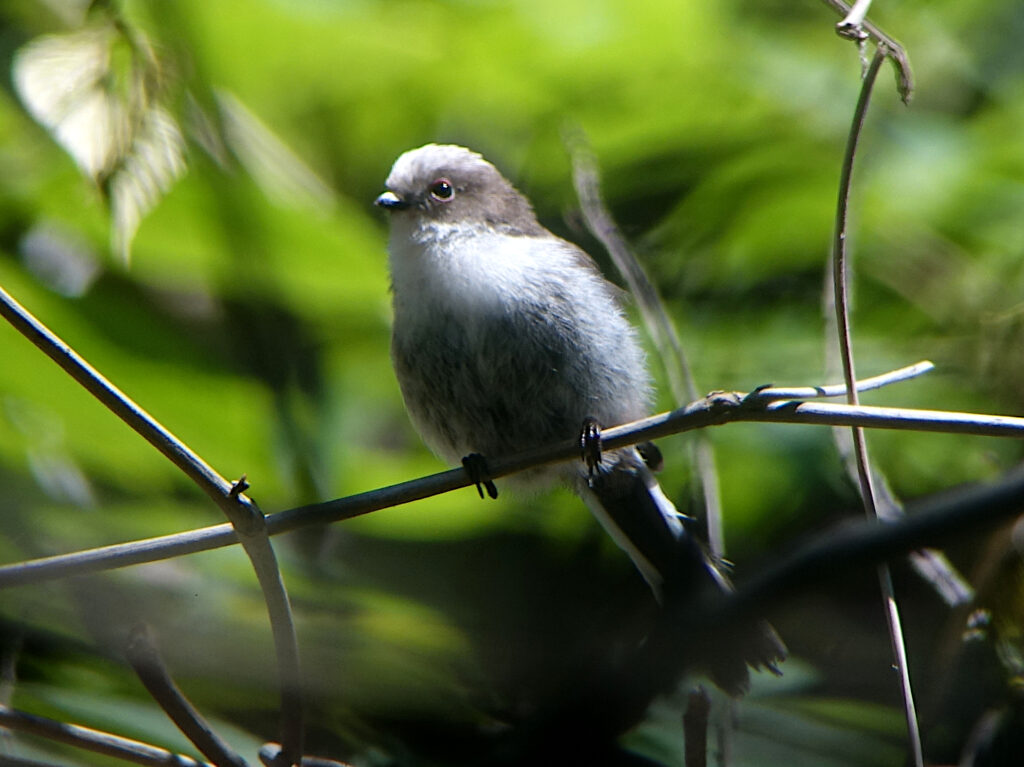
Unlike Silver-throated Bushtit, Long-tailed Tits are widespread and locally numerous in the ROK, and have a very wide distribution from Japan to western Europe.

There are two or much less likely three sub-species of Long-tailed Tit in the ROK: (1) The super-gorgeous and occasionally irruptive white-headed caudatus which breeds on Baengnyeong Island northward, and less frequently elsewhere close to the inner border, and can be much more widespread in winter (being recorded at least as far south as e.g., Heuksan Island in Shinan County); (2) The still cute and dark head-striped magnus (either part of the widely-distributed europeaus group or of the Far East Asian trivirgatus group: see Harrap 2020), found commonly throughout the mainland, which I also recorded once in the DPRK, in Rason in the far northeast; and (3) trivirgatus on Jeju Island, according to some authorities, e.g.. Harrap (2020). Gill et al. (2024) however, more logically, confine trivirgatus to “c Japan”; and as such this taxon, currently included on the Birds Korea checklist with a question mark, will be removed.


Also in northeast Asia, though unrecorded in Korea and not yet recognised as a subspecies by either Harrap (2020) or Gill et al. (2024), is the japonicus subspecies of Hokkaido and the Kuriles, identified through detailed analysis by Lukyanchuk et al. (2017).
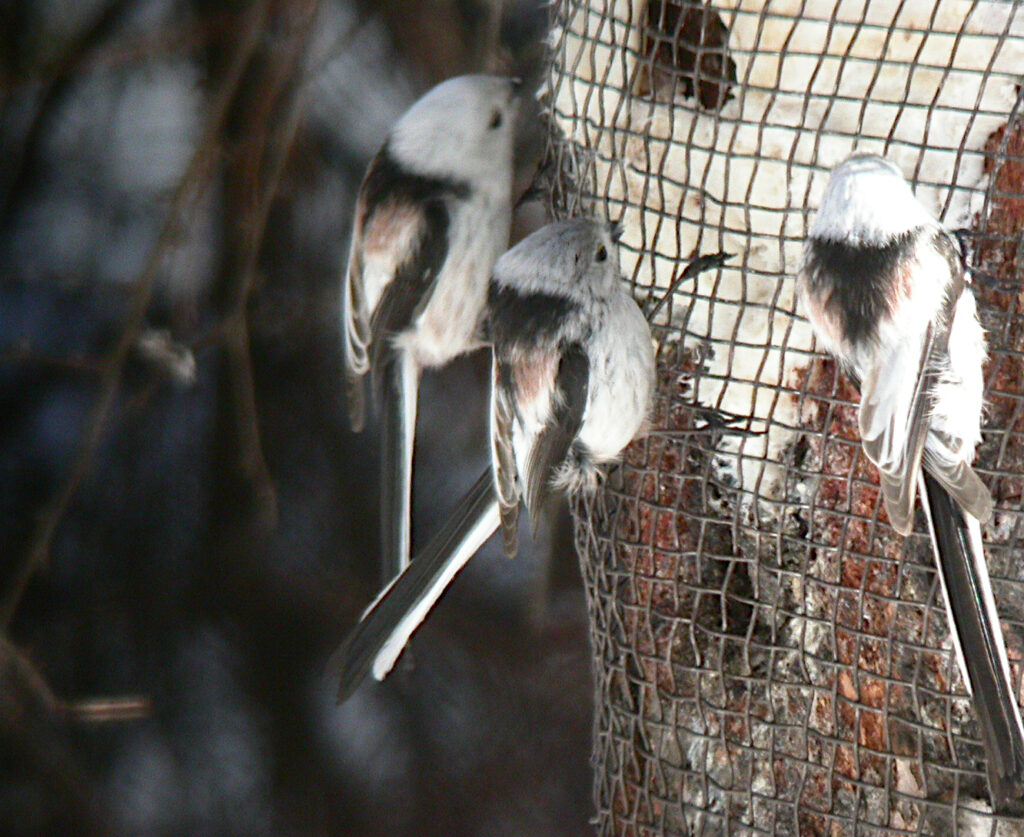
Plumage differences between the more southerly-distributed magnus and the more northerly-distributed caudatus Long-tailed Tit in field conditions are obvious, with magnus having a narrow dark line across the lores, which broadens substantially above and behind the eye, continuing unbroken as black lateral crown stripes towards the extensively black nape and upperparts. Many also show a broken, irregular, weak blackish band across the breast. In addition, the pink on the flanks and undertail coverts tends to be paler and less striking than in caudatus in Korea; and many appear to show rather narrower white outer edges to the tertials.

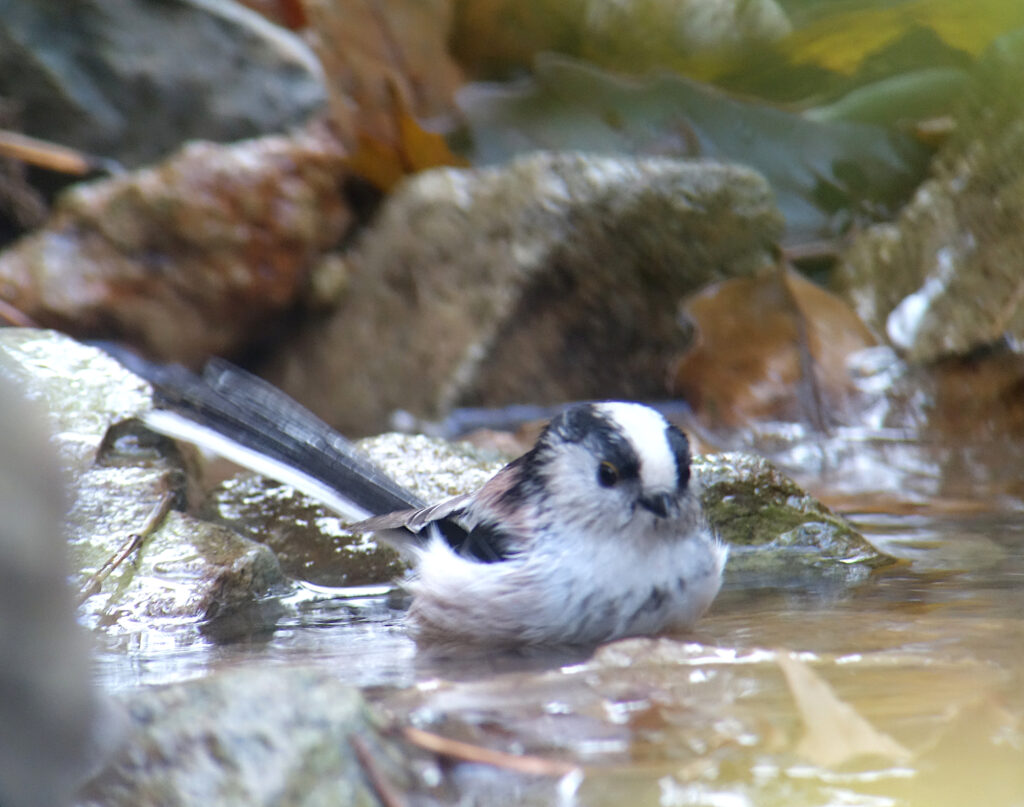
Near the Korean inner border, magnus and caudatus occasionally pair up together to breed, including on Baengnyeong Island, and out of juvenile plumage these intergrades can easily be identified because they show greatly reduced dark in the lateral crown stripes, ranging from slightly faded to almost absent, perhaps invariably showing more obviously to the rear of the stripe. Such birds can turn up almost anywhere during winter irruptions, suggesting that these two taxa probably breed together quite regularly to the north of the ROK as well.
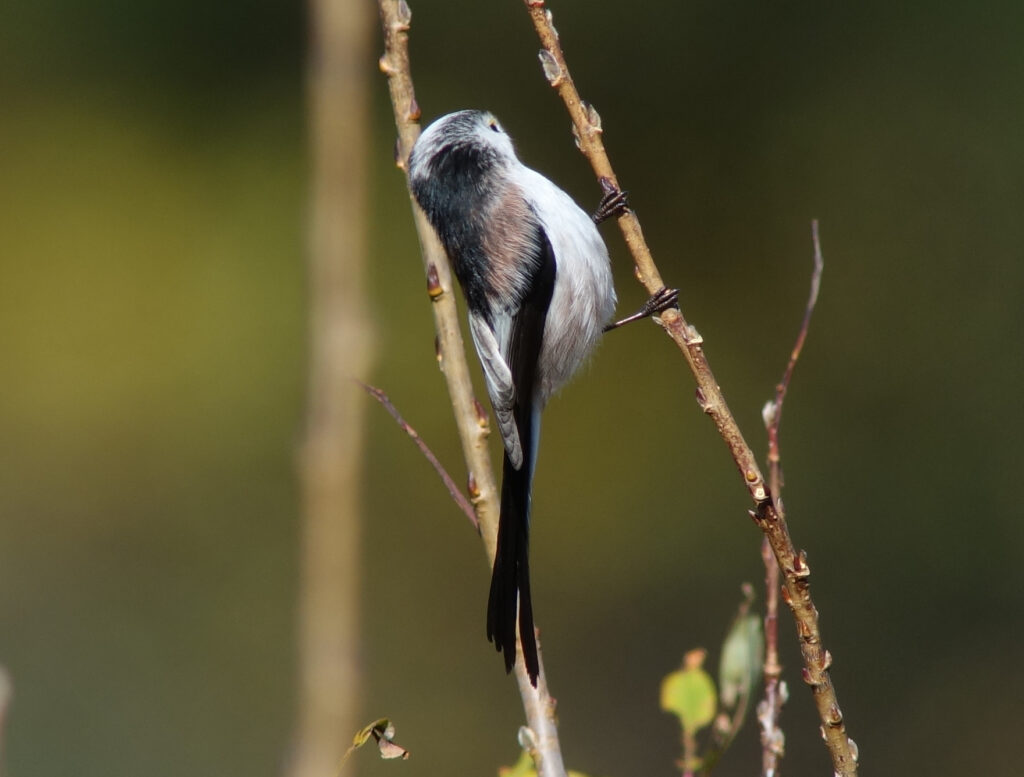
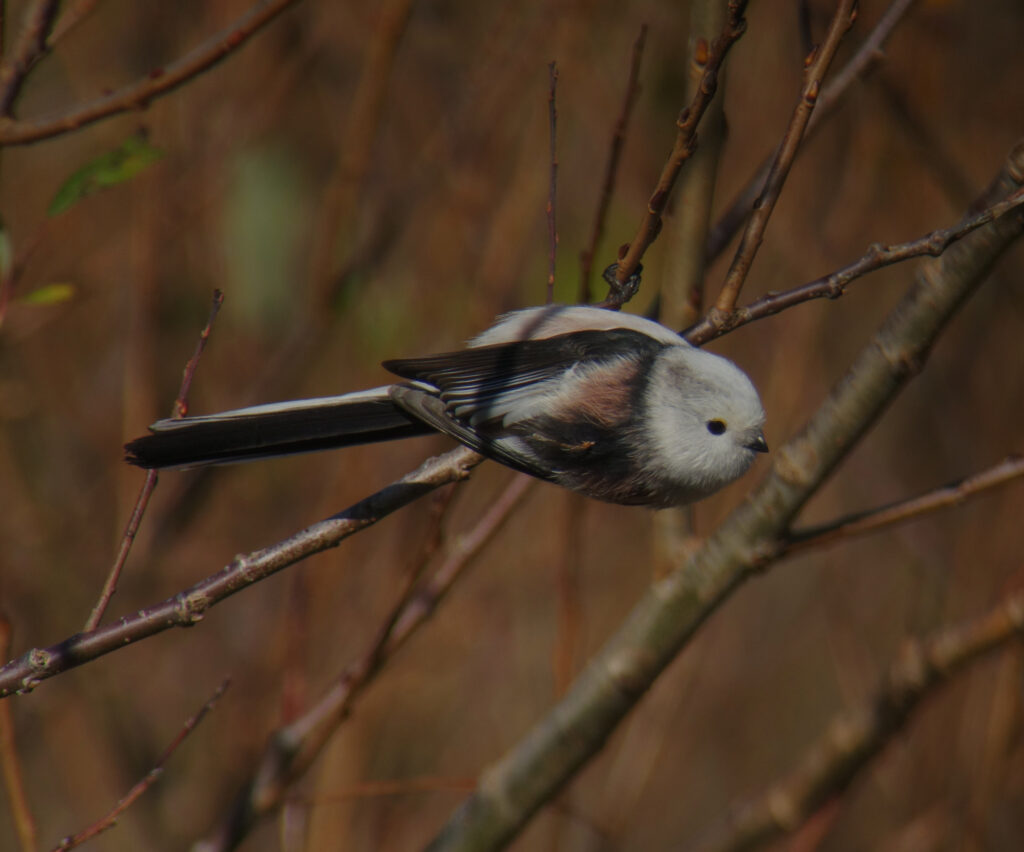

Easily accessible literature suggests that hybridisation between Silver-throated Bushtit and Long-tailed Tit is unusual or rare. For example, Geldard et al. (2020) assert that there were “no reports of regular intergradation or hybridization in northeastern China” where ranges marginally overlap, although “Apparent ‘intergrades’ have been recorded as migrants in coastal Hebei, but the origin and status of these are unknown’. By extension, hybrids seem highly unlikely in Korea, hundreds of km distant from the mapped zone of overlap of the two species – while being within 180km of the regular range of Silver-throated in Shandong. However, a documented hybrid pairing in Beijing in 2024 and the influx of obvious hybrids on Baengyeong seen in October 2024 puts an end to such thinking: hybrids can be found in Korea. Such birds also help with the development of criteria for identifying hybrids, which will be useful for eBirders (although this hybrid combination could not be entered on eBird in October 2024, Marshall Iliff mailed in November to say that it will soon be added).
Main hybrid features to look for appear to include: very wide breaks in the forehead band; black on the nape; lack of grey in the uppertail; and pink tones on the scapulars. Several of the birds posted in the Macaulay library as Silver-throated Bushtit might therefore be hybrids, including birds in Beijing from at least 2018 and Shandong in 2017. In addition, at least one of the four Silver-throated Bushtit on Baengnyeong in November 2022 (and the only one to be properly digiscoped) can now be confidently re-identified as a hybrid Long-tailed Tit x Silver-throated Bushtit, with one parent most likely a magnus: Figures 27-28). Where did this hybrid originate? Could this have fledged on Baengnyeong in May or during the summer? Or did this bird arrive from the DPRK or PR China?


In 2024, following very strong northwesterly winds, multiple hybrids were seen at Dumujin in the northwest of Baengnyeong Island on October 24th, 2-3 of which were documented in video and still photographs by Kim Eojin ; and at least two more were seen in the southwest at Junghwadong on October 26th by myself and Subhojit Chakladar, in a large flock of 30+ Long-tailed Tits. No Long-tailed Tits, Silver-throated Bushtits or hybrids were seen in the following five days of field work – suggesting that the birds had moved on – but to where?



Based on the range maps on eBird (Figures 3 & 18) and weather conditions prior to their observation, it seems probable that the hybrids and the carrying flocks they were with originated from Liaoning Province in PR China, the closest mapped location with multiple records of both Long-tailed Tit and Silver-throated Bushtit (or if not, from the adjacent mainland Hwanghaenam in the DPRK, where there are no eBirders yet…).
In summary, if you see an out-of range Silver-throated Bushtit in Korea or in China, it is worth ruling-out (or ruling-in!) a hybrid origin as part of the ID. Hybrids can be with either nominate or with dark head-striped Long-tailed Tit. Hybrids with nominates should be immediately obvious. In magnus-type hybrids, first check:
- The black forehead band. A small break in the centre of the band does not seem to be proof of hybrid origin, but a wide break is;
- Black on the nape;
- Any pink or white on the scapulars.
Thanks again especially to Kai Pflug in Shanghai (and to Andy Lee for contacting him on my behalf), Terry Townshend in Beijing and Kim Eojin for providing their highly educational images specifically for this post; and to Subhojit Chakladar for sharing his image for an earlier post on Baengnyeong.
As always, everyone’s feedback would be much appreciated.
References
Geldard, R. P., S. Harrap, and A. J. Spencer (2020). Silver-throated Tit (Aegithalos glaucogularis), version 2.0. In Birds of the World (S. M. Billerman and B. K. Keeney, Editors). Cornell Lab of Ornithology, Ithaca, NY, USA. https://doi.org/10.2173/bow.lottit5.02
Gill F, D Donsker & P Rasmussen (Eds). 2024. IOC World Bird List (v14.2). doi : 10.14344/IOC.ML.14.1.
Harrap, S. (2020). Long-tailed Tit (Aegithalos caudatus), version 1.0. In Birds of the World (J. del Hoyo, A. Elliott, J. Sargatal, D. A. Christie, and E. de Juana, Editors). Cornell Lab of Ornithology, Ithaca, NY, USA. https://doi.org/10.2173/bow.lottit1.01
Lukyanchuk, O. A., Mariva, I. M. & Ya.A. Redkin. 2017. Geographical Variability of Morphological and Acoustic Signs of the North Populations of the Long Tailed Tit Aegithalos caudatus (Passeriformes, Aegithalidae) Biology Bulletin, 2017, Vol. 44, No. 9, pp. 1023–1031. © Pleiades Publishing, Inc., 2017. ISSN 1062-3590









